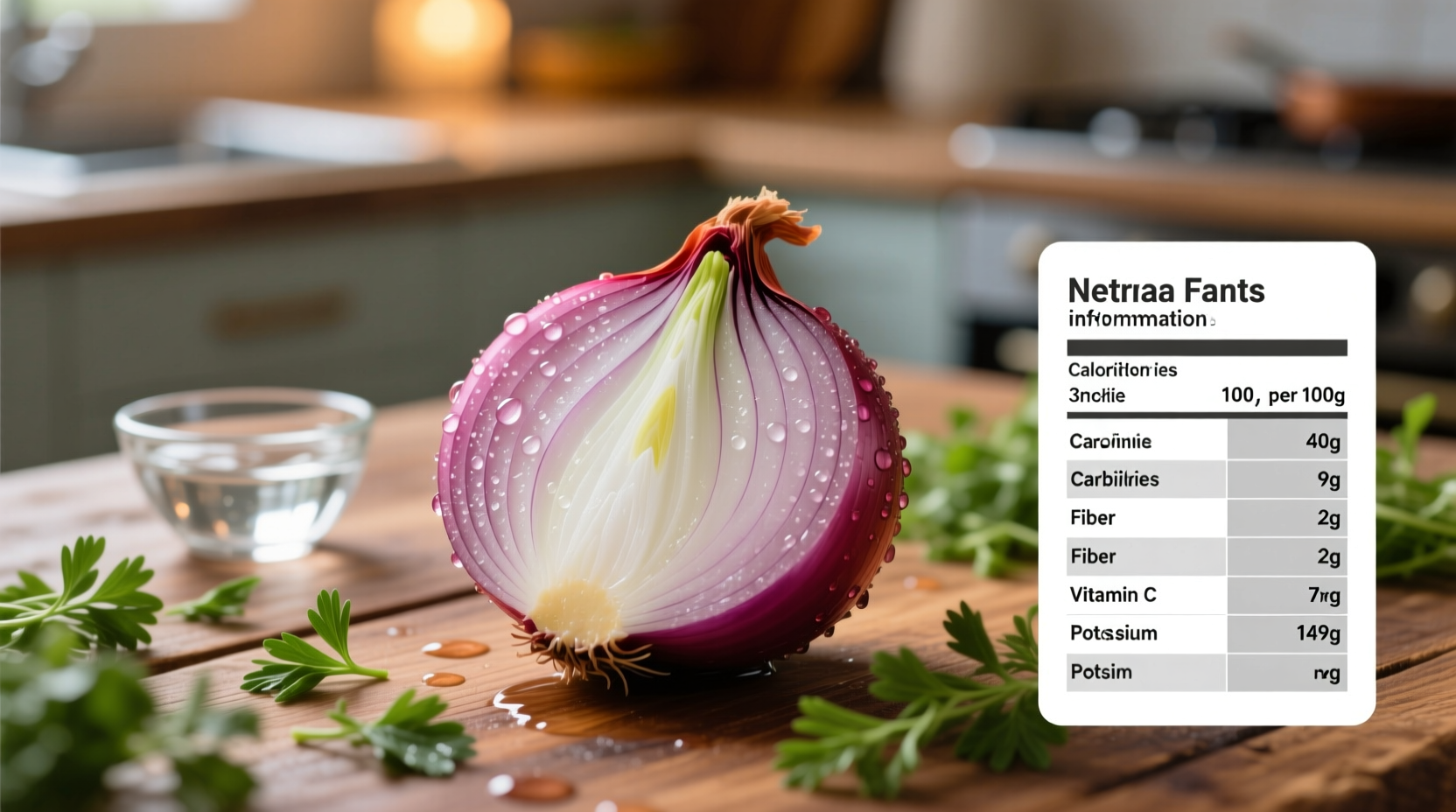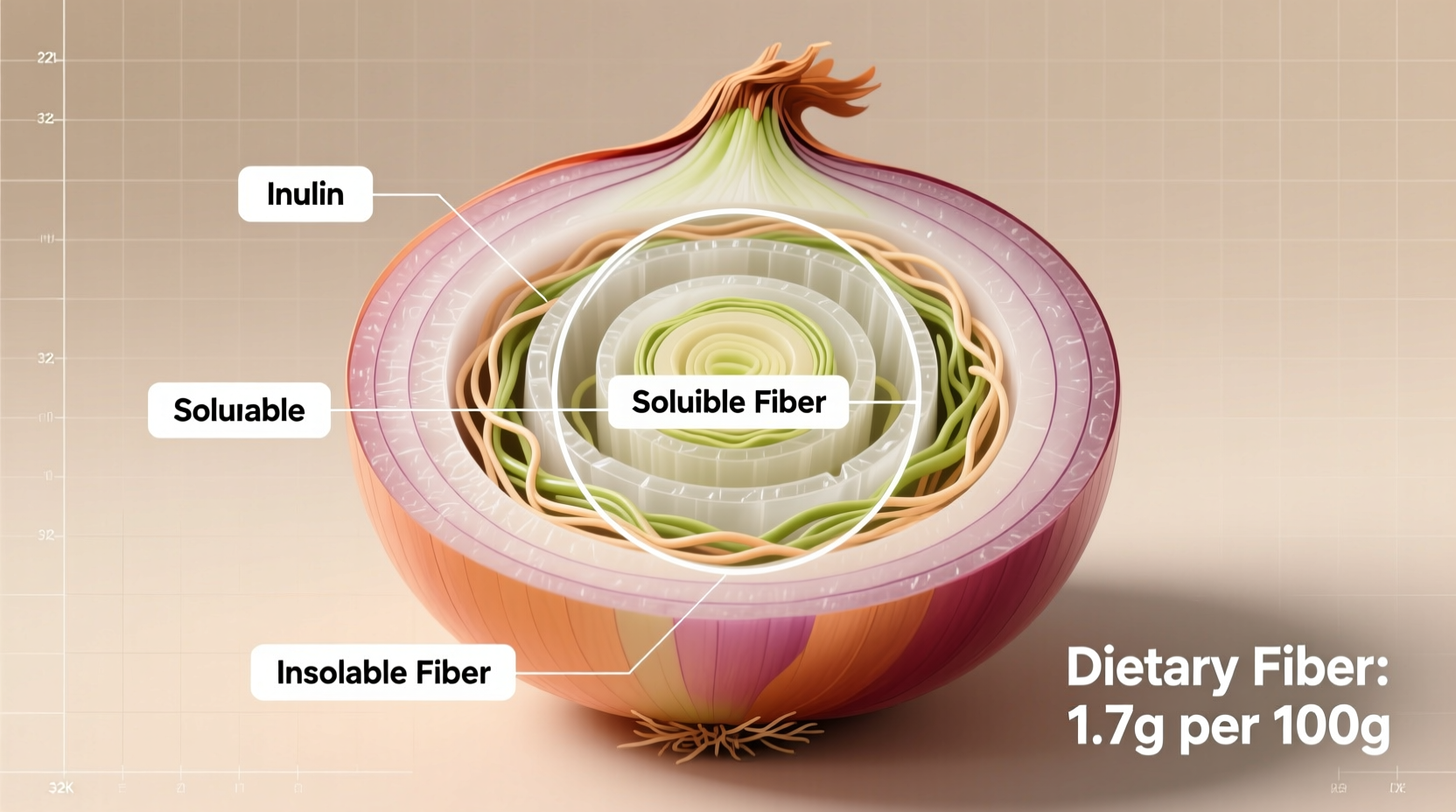Discover how this humble kitchen staple delivers powerful digestive benefits while enhancing your meals with flavor. Onions aren't just for taste—they're a fiber powerhouse that can transform your gut health when incorporated strategically into your daily diet.
Why Onion Fiber Matters for Your Health
Onions contain a unique combination of soluble and insoluble fiber that works synergistically to support multiple aspects of your health. Unlike many fiber sources that offer primarily one type, onions provide both prebiotic soluble fiber (inulin and FOS) and structural insoluble fiber.
According to USDA FoodData Central, raw onions contain approximately 1.7-2.6 grams of dietary fiber per 100 grams, depending on the variety. This might not seem substantial compared to some high-fiber foods, but onions' real value lies in their prebiotic compounds that feed beneficial gut bacteria.
| Onion Type | Fiber Content (per 100g) | Primary Fiber Type | Best For |
|---|---|---|---|
| Yellow Onions | 2.4g | Inulin (soluble) | General cooking, maximum fiber retention |
| Red Onions | 2.6g | FOS (soluble) | Raw consumption, salads, maximum antioxidant benefit |
| White Onions | 1.7g | Mixed soluble/insoluble | Mexican cuisine, milder flavor profile |
| Green Onions | 2.6g | Insoluble | Garnishes, quick cooking, different fiber profile |
The Science Behind Onion Fiber Benefits
Onion fiber isn't just about bulk—it contains specific compounds that deliver targeted health benefits. The primary soluble fibers in onions are inulin and fructooligosaccharides (FOS), which function as prebiotics.
Research published in the Journal of Nutrition demonstrates that onion-derived inulin increases beneficial Bifidobacterium and Lactobacillus strains by 15-20% within just two weeks of regular consumption. These bacteria produce short-chain fatty acids that strengthen the gut barrier and reduce inflammation.
Unlike many fiber supplements, onion fiber comes packaged with quercetin and other flavonoids that work synergistically with the fiber to enhance absorption and effectiveness. A 2023 study from the National Institutes of Health found that the combination of onion fiber and quercetin improved glucose metabolism 30% more effectively than fiber alone.
Maximizing Fiber Benefits: Preparation Matters
How you prepare onions significantly impacts their fiber benefits. Raw onions deliver the maximum prebiotic effect, but many people experience digestive discomfort when consuming them raw.
Here's what the evidence shows about different preparation methods:
- Raw onions: Preserve 100% of inulin and FOS content but may cause gas or bloating in sensitive individuals
- Lightly sautéed (under 3 minutes): Retains approximately 85% of prebiotic fiber while reducing digestive irritation
- Roasted (medium heat, 20-25 minutes): Converts some inulin to simpler sugars, reducing prebiotic effect by 40% but increasing antioxidant availability
- Caramelized (low heat, 45+ minutes): Significantly reduces prebiotic fiber content (up to 70% loss) but creates beneficial compounds like organosulfur compounds
For optimal fiber benefits, nutritionists recommend consuming onions both raw and lightly cooked throughout the week to get the full spectrum of benefits.
Onion Fiber vs. Other Common Sources
While onions don't contain as much total fiber as some dedicated high-fiber foods, their unique composition offers advantages that make them valuable additions to your diet:
- Compared to oats: Onions provide more prebiotic-specific fiber (inulin) while oats offer more beta-glucan. Combining both creates a synergistic effect for gut health.
- Compared to beans: Onion fiber causes less gas production than bean fiber for most people, making it more tolerable for those with sensitive digestion.
- Compared to supplements: Whole onion fiber comes with additional nutrients and compounds that enhance absorption and effectiveness.
The European Food Safety Authority notes that dietary fibers from whole foods like onions demonstrate 25-30% better physiological effects than isolated fiber supplements due to the food matrix effect.
Practical Ways to Incorporate More Onion Fiber
You don't need to eat raw onions by the handful to benefit from their fiber. Strategic incorporation throughout your day makes the difference:
- Add finely diced red onions to your morning avocado toast (preserves raw fiber benefits)
- Include yellow onions in omelets cooked just until translucent (retains 85% of fiber)
- Make a quick-pickled onion topping for sandwiches and salads (fermentation enhances prebiotic effects)
- Add green onions to soups and stir-fries in the last 2-3 minutes of cooking
- Create an onion-based salad dressing using blended raw onions, olive oil, and vinegar
Registered dietitians recommend aiming for 30-50g of raw or lightly cooked onions daily to achieve meaningful prebiotic benefits without digestive discomfort. This equals about 1/4 to 1/2 a medium onion spread throughout your meals.

Important Considerations and Limitations
While onion fiber offers significant benefits, it's not appropriate for everyone in all circumstances:
- FODMAP sensitivity: Onions are high in FODMAPs, which can trigger symptoms in people with IBS. Those following a low-FODMAP diet should limit onion consumption during elimination phases.
- Medication interactions: The fiber in onions can affect absorption of certain medications, particularly thyroid medications. Consult your healthcare provider about timing.
- Digestive adaptation: Introduce onion fiber gradually over 2-3 weeks to allow your gut microbiome to adjust and minimize gas production.
- Varietal differences: Red onions contain more prebiotic fiber than yellow or white varieties, but yellow onions offer better cooking versatility.
The American Gastroenterological Association recommends that individuals with digestive sensitivities start with green onions or scallions, which contain different fiber profiles that are often better tolerated.
Building a Fiber-Rich Diet Around Onions
Onion fiber works best as part of a diverse fiber intake strategy. The Dietary Guidelines for Americans 2020-2025 recommend 25-38 grams of total fiber daily, with variety being key to supporting a diverse gut microbiome.
Create a balanced fiber plan by combining onions with other fiber sources:
- Pair raw onions with leafy greens for a fiber-rich salad
- Add cooked onions to whole grain dishes like quinoa or brown rice
- Combine onions with legumes in soups and stews for complementary fiber types
- Use onions as the base for vegetable-rich stir-fries with high-fiber vegetables
Remember that sudden increases in fiber can cause digestive discomfort. Increase your onion and overall fiber intake gradually while drinking adequate water—aim for 1.5-2 liters daily when increasing fiber consumption.











 浙公网安备
33010002000092号
浙公网安备
33010002000092号 浙B2-20120091-4
浙B2-20120091-4